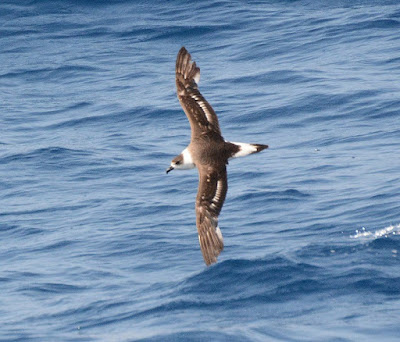The Norwegian Epic in Ponta Delgada, Azores, harbor, November 11, 2017. The balcony from stateroom 10097 provided an excellent platform from which to observe seabirds
We sailed from Barcelona, Spain, on November 5, 2017, aboard the Norwegian Epic cruise ship arriving in Port Canaveral Florida on November 18. During the 13-day trip we made stops in Malaga, Spain, and at Ponta Delgada in the Azores. Our stateroom was on Deck 10 and it had a balcony on which I spent most of the daylight hours each day we were at sea. Below is a list in taxonomic order of the birds observed from the ship while at sea with occasional notes about some of the observations.
Common Loon - offshore from Isla Ibiza in the Mediterranean
Northern Fulmar - 1 in Bahamas waters
Black-capped Petrel - 1 near Bermuda
Fea's/Zino's/Soft-plumaged Petrel - an unidentified Pterodroma of the Soft-plumaged complex 140 miles offshore from Portugal.
Bulwer's Petrel
Cory's Shearwater - the most common tubenose
Great Shearwater - 1 in Portugal waters
Manx Shearwater - in the middle of the Atlantic Ocean!
Yelkouan Shearwater - in the Mediterranean
Balearic Shearwater - in the Mediterranean
Audubon's Shearwater - in Bahamas waters
Little Shearwater - offshore from Portugal
European Storm-Petrel
Leach's Storm-Petrel
Band-rumped Storm-Petrel - near the Azores where this species nests
White-tailed Tropicbird - at 2 different mid-ocean locations including one swimming on the surface of the ocean
Brown Booby - 1 juvenile in Bermuda waters
Northern Gannet - abundant offshore from Portugal
Great Skua - 5 birds offshore from Portugal
Pomarine Jaeger
Parasitic Jaeger
Black-legged Kittiwake - Portugal waters
Sabine's Gull
Yellow-legged Gull - abundant in the Mediterranean and common in the Atlantic. Last one seen was 570 miles southwest of Flores Island in the Azores. This or a different Yellow-legged Gull remained with our ship for 4 days while at sea.
Lesser Black-backed Gull
Gray Wagtail (!). One bird, an apparent migrant, came aboard the ship and rested on the rail of our balcony while offshore from Alicante, Spain in the Mediterranean
Other Wildlife:
Unidentified Whales - 2 spouts were observed one day out of the Azores but I was unable to identify them to species. Both Humpback and Sperm Whales are regular migrants in that area.
Ocean Sunfish
Roseate Tern - Although not seen on the open ocean, this term was quite common in Ponta Delgada harbor in the Azores and also seen while we were being taken to a couple of scuba diving sites east of Ponta Delgada.
This was our second Transatlantic crossing - the first from Copenhagen to Miami in October 2014. Species diversity was similar on both trips although birds were much more numerous on the October crossing. Transatlantic cruises are a relatively cheap way to observe a variety of seabirds. Our 13-day trip cost $799 per person or about $61 a day which is a very cheap pelagic trip. Our next Transatlantic cruise will be in April 2019 from Miami to Rome. Im interested in how different the abundance and diversity will be during spring migration as opposed to fall.
The approximate route followed on this cruise
The only thing I don't like about going on a curise is putting everything behind you
The approximate route followed on this cruise
The only thing I don't like about going on a curise is putting everything behind you















No comments:
Post a Comment